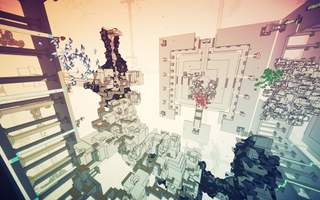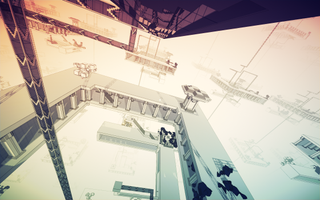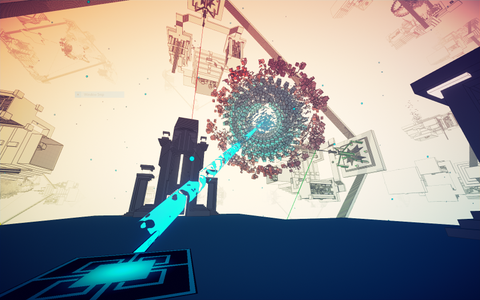Our Verdict
A serene gravity flipping puzzler with impossible structures to wrap your head around.
PC Gamer's got your back
What is it? A first-person physics puzzler with impossible architecture
Expect to pay $20
Developer William Chyr Studio
Publisher In-house
Link Official site
There have been quite a few games that play with gravity—Antichamber's mind-bending puzzles, or Dandara's explosive wall-jumping. William Chyr's first-person physics-based puzzler, Manifold Garden, also lets you mess with the force of gravity, but in this game, your playground is the neverending, boundless realms of infinity—not terrifying at all.
Waltz up to any visible surface in Manifold Garden's geometrical world and it lets you flip gravity so that the wall becomes the floor. Using this perspective-shifting ability, players are tasked with solving a number of gravity manipulation puzzles and work out how to progress through Manifold's many eternal spaces.
You're forever being confronted with colossal towers, cathedral-like buildings, massive windows, neverending flights of stairs—it's bonkers. There are giant cubic trees that grow square blocks that you can pluck from their branches like fruit. As you walk through geometric runes your footsteps echo through the tower's many impossible floors and doorways.
Manifold Garden's puzzles, thankfully, are not impossible and require you to move cubes onto buttons. Sounds simple enough, but the catch is, unlike Portal's companion cubes, these can only be moved when they share the player's gravitational orientation and the matching button is past a number of obstacles.
These puzzles take place on immense floating structures that require you to wrap your brain around navigating impressive spaces. Flipping from one surface to the next and running across expansive parts of the architecture feels like trying to solve a Rubix Cube, examining all the different sides and possible moves to get a clear idea. Taking inspiration from Escher's Relativity print, one moment you'll be running up some stairs and slowly it will shift so that you're actually going down them.
Manifold's world is cleverly shaped so that it wraps around itself in a never-ending loop, meaning that if you look out into the distance you can see the same structure that you're standing on mirrored all around you. It's like standing in one of Yayoi Kusama's famous Infinity Mirror Rooms. These rooms are lined from floor to ceiling with large, glossy mirrors and as you step into the space, the reflection of the mirrors creates the illusion that you are floating in midair with an infinite landscape stretched before you.

Manifold Garden transports you directly into that space, a place where you can explore the spectacular and spellbinding idea of infinity. Stepping off the edge on one of these structures, you'll fall directly into the structure underneath you, one of its many twins. A useful way of getting around the maze of Pagodas and walkways.
Flipping and free-falling from one surface to the next completely twisted my perspective of the world but Chyr has created some simple but effective signals so that you don't lose your head. Each direction of gravity is assigned a colour, meaning that all surfaces and objects that align to that direction are colour coded. For example, I could see which way the red cube was going to fall because it would fall onto a red surface. There are also music cues that play when you're on the right track, and parts of the environment will emit a pulse showing you where to go when you have finished a puzzle.
As you traverse Manifold Garden's impossible structures and solve its many puzzles a narrative starts to emerge, but given its wordless minimalism it's all very interpretive. There are clues that you are rebuilding something, restoring ancient runes, recovering cubes from a lost civilisation, and planting seeds to grow trees, but it's hard to say exactly what is going on.

For me though, Manifold's ambiguous story added to the mysticism of the game and emphasised its weird otherworldly vibe. The ambient music and soft chimes make you feel like you're entering a calm sacred space, but it also has moments of explosive force where the architecture comes crashing around you in a million tiny pieces only to then get rebuilt into another world.
It's a joy to try and work out Manifold Garden's impossible geometry and world wrapping. It's an intricate and impressive spectacle and one that took William Chyr seven years of development to make—and it shows. When I finished playing it the first time I immediately started again, just to revisit some of those infinity rooms. It's strange that a gravity puzzle so grounded in physics can emit a serene, almost divine, energy—it's like a unity of two worlds. With Manifold Garden, Chyr has joined two opposing forces creating an ethereal physics puzzler.
A serene gravity flipping puzzler with impossible structures to wrap your head around.
Rachel had been bouncing around different gaming websites as a freelancer and staff writer for three years before settling at PC Gamer back in 2019. She mainly writes reviews, previews, and features, but on rare occasions will switch it up with news and guides. When she's not taking hundreds of screenshots of the latest indie darling, you can find her nurturing her parsnip empire in Stardew Valley and planning an axolotl uprising in Minecraft. She loves 'stop and smell the roses' games—her proudest gaming moment being the one time she kept her virtual potted plants alive for over a year.

